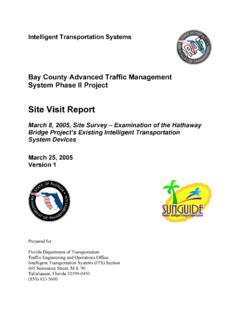Transcription of DISSEMINATOR - floridaits.com
1 The SunGuide DISSEMINATOR is a publication of: florida Department of TransportationTraffic Engineering and Operations Office605 Suwannee Street, MS 36 Tallahassee, florida 32399-0450(850) 410-5600 2015 Inside This Issue1 FTE Wrong-Way Driving Pilot Project Shows Promise ..1I-595 Reversible Toll Lanes Status Application ..3 District Seven CEI ITS Training Tower Infrastructure Upgrade and Replacement ..6 Connected Commercial Vehicles ..7 FDOT District Six Replaces Signs in Miami-Dade County ..8 ITS florida : President s Message ..9 Editorial Corner: Using Data to Improve florida s Roads ..11 FDOT ITS Contacts ..12 FTE Wrong-Way Driving Pilot Project Shows PromiseBy John Easterling and Eric Gordin, florida s turnpike EnterpriseAfter months of planning, and modest signage and pavement marking improvements, the florida s turnpike Enterprise deployed its ramp-based wrong-way driving detection and deterrent system in mid-October 2014.
2 The pilot project, encompassing six interchanges and ten ramps along the Homestead Extension of florida s turnpike in Miami-Dade County and five interchange ramps on the Sawgrass Expressway in Broward County, initially implemented enhanced signage and pavement markings at the ramp locations. As of October 16, 2014, florida s turnpike Enterprise commenced implementation and operation of the ramp-based detection and deterrent system. This pilot project included the selection and deployment of light-emitting diode (LED)-highlighted flashing signage, multiple coordination meetings with florida Highway Patrol (FHP) Troop K, their Lake Worth Regional Communications Center, and local law enforcement agencies to establish access to the web interface (provided by the manufacturer) for monitoring and alerts at each remote site location.
3 With the integration of the ramp technologies to the transportation Centennial1915 2015 DISSEMINATORF lorida Department of Transportation s Traffic Engineering and Operations NewsletterLED highlighted Department of TransportationSunGuide DISSEMINATOR February 2015management center (TMC), turnpike TMC operators and FHP dispatchers in Lake Worth have been monitoring the manufacturer s web site, which allows for immediate notification and visual verification of a wrong-way vehicle entry. The ramp technology utilizes front and rear radar as well as a high quality camera to capture images of the vehicle that activates the sign and generates an alert. When a vehicle enters the ramp in the wrong direction, the front radar first activates the sign and triggers the camera to begin taking images.
4 As the vehicle passes the camera, the images are reviewed to determine motion in the wrong direction. Once the vehicle passes the camera and is detected by the rear radar, the images and time stamp of the event are transmitted wirelessly over a commercial cellular network to the web interface hosted by the manufacturer. The TMC and FHP regional communications center continually monitor the web site for an audible alarm, which is triggered when the web site is populated with event data. This occurs within approximately 60 seconds of the field event, allowing TMC operators to respond to the event, view the wrong-way driver on available closed-circuit television cameras, coordinate with the FHP dispatch, notify any Road Ranger service patrol located in close proximity, and activate dynamic message signs (DMS) in the approximately three months of operation, six vehicles have been detected entering the project sections in the wrong direction, all of which have resulted in a complete activation of TMC and FHP response plans, including DMS messaging in both directions for a 20 mile area advising motorists that a wrong-way driver has been reported and to use extreme caution.
5 Evidence to date suggests that all vehicles have self-corrected, as no crashes have been reported. As evaluation of the pilot program continues, florida s turnpike Enterprise realizes the importance in site selection to minimize the impact to motorists due to frequent sign flashing. As several sites are located at interchanges where on-ramp and off-ramp traffic movements are adjacent to each other, on-ramp traffic frequently activates the forward facing radar causing the signs to flash. These sites have already been selected for relocation to reduce this occurrence. For information, please contact Mr. Gordin at (407) 264-3316 or e-mail to * * *Example photo from wrong-way detection on 1/2/20153 florida Department of TransportationSunGuide DISSEMINATOR February 2015I-595 Reversible Toll Lanes Status ApplicationBy Daniel Smith, FDOT District FourOver the last several years, the florida Department of Transportation (FDOT) District Four Intelligent Transportation Systems (ITS) Unit has focused on giving regional transportation management center (RTMC) operators the tools to enhance situational awareness on the status of the District Four transportation network.
6 Every operator workstation is equipped with a mini-video wall. To further enhance situational awareness, speed data is projected onto vacant walls in the control room, and real-time performance measures and incident data are readily available on the video wall. An enhancement this year added an I-595 reversible toll lanes status application to provide a real-time overview of the dynamic features of the I-595 reversible toll segment. This web-based application interfaces with the I-595 Express advanced traffic management system to obtain the flow state of the reversible segment and the operational state of all the gates and barriers at the segment s entry points. The application also interfaces with the dynamic pricing system used to obtain the current toll amount for the District Four currently displays information from this application using high-definition projectors that flank the operations room at the District Four RTMC.
7 The application s dashboard shown below presents a depiction of the I-595 reversible lanes along with major interchanges, entry and egress ramps, and other dynamic data that is updated in near real-time. Express lanes on I-595 reversible lanes are typically open on weekdays to eastbound traffic between 4 and 1 and for westbound drivers between 2 and 2 The express lanes are normally closed between 1 and 2 and between 2 and 4 for routine maintenance. On weekends, the express lanes are normally open in the eastbound direction only. This big picture information is available at a glance to managers and operators to enhance system operations and provide our customers with a seamless experience on the District s roadways. The biggest beneficiaries of these improvements are the traveling public and RTMC operators.
8 At a glance, operators are able to spot changes in traffic flow, possibly saving minutes and lives while making their camera checks. For information, please contact Mr. Smith at (954) 847-2785 or e-mail to * * *Speed data projected onto vacant walls in the TMC control room, and real-time performance measures and incident data are readily available on the video wall. Reversible lanes open in the westbound Department of TransportationSunGuide DISSEMINATOR February 2015 District Seven CEI ITS Training SummaryBy Terry Hensley, FDOT District Seven, and Jonathan Tursky, TransCoreIntelligent transportation systems (ITS) installations are highly complex and technical systems requiring specific skill florida Administrative Code indicates that roadway construction, engineering, and inspection (CEI)
9 Work includes the administration and inspection of single or multiple construction contracts on rural, municipal, urban, and interstate facilities and requires at least one professional engineer, registered with the florida State Board of Professional Engineers, having at least two years of responsible charge experience as a project engineer on a roadway construction inspection project. The District Seven CEI Scope of Services states, It shall be the responsibility of the CEI Consultant to administer, monitor, and inspect the Construction Contract such that the project is constructed in reasonable conformity with the plans, specifications, and special provisions for the Construction Contract. Observe the Contractor s work to determine the progress and quality of work.
10 Identify discrepancies, report significant discrepancies to the Department, and direct the Contractor to correct such observed discrepancies. Over the progress of several construction projects that included ITS installations, the florida Department of Transportation (FDOT) District Seven ITS staff worked with the FDOT CEI staff to provide information and guidance to the field CEIs. During this time, it was determined that the majority of field CEIs had no training and little or no experience with ITS. So this begged the question, how can an engineer/inspector, without any ITS training or experience, effectively carry out the CEI requirements and duties? The obvious response is that they cannot be expected to do so. Although a great amount of experience exists within these teams in regards to actual roadway construction, ITS is a fairly new addition to these projects and, therefore, deserved additional explanation and training.



